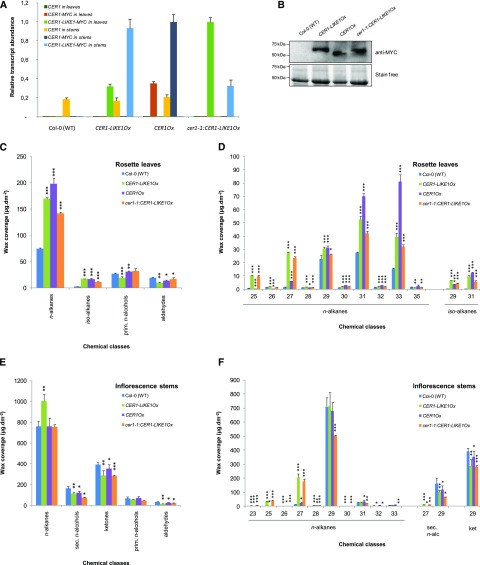Figure 6.
Molecular and biochemical characterization of CER1-LIKE1 overexpressing plants. A, RT-qPCR analysis of CER1-LIKE1 and CER1 gene expression in leaves and stems of the different overexpressing lines CER1-LIKE1Ox, CER1OX, and cer1-1:CER1-LIKE1Ox compared to wild-type plants as indicated above. The relative transcript abundance of ACT2 and eIF-4A-1 in each sample was determined and used to normalize for differences of total RNA amount. Results for each gene are presented as transcript abundance compared to maximal expression level in leaves and stems, respectively. The data represent the means ± sd of three replicates. B, Immunoblot analysis of protein extracts of the different lines expressing MYC-tagged forms of CER1 or CER1-LIKE1 compared to wild-type plants as indicated above. Total proteins were imaged using Stain-free technology and used for equal loading control. C, Cuticular wax composition, by chemical class, of leaves of wild-type (Col-0), CER1-LIKE1Ox, CER1OX, and cer1-1:CER1-LIKE1Ox lines. Amounts of components are expressed as µg·dm−2. The data represent the means ± sd of three replicates (prim. n-alcohols, primary fatty alcohols). Significant differences were assessed by Student’s t test (*P < 0.05; **P < 0.01; ***P < 0.001). D, Carbon-chain-length distribution within the major cuticular compound classes of leaves of wild-type (Col-0), CER1-LIKE1Ox, CER1OX, and cer1-1:CER1-LIKE1Ox lines. Amounts of components are expressed as µg·dm−2. Each wax constituent is designated by carbon chain length and is labeled by chemical class along the x axis. The data represent the means ± sd of three replicates. Significant differences were assessed by Student’s t test (*P < 0.05; **P < 0.01; ***P < 0.001). E, Cuticular compound composition, by chemical class, of stems of wild-type (Col-0), CER1-LIKE1Ox, CER1OX, and cer1-1:CER1-LIKE1Ox lines. Amounts of components are expressed as µg·dm−2. The data represent the means ± sd of three replicates. Significant differences were assessed by Student’s t test (*P < 0.05; **P < 0.01; ***P < 0.001). F, Carbon-chain-length distribution within the major cuticular compound classes of stems of wild-type (Col-0), CER1-LIKE1Ox, CER1OX, and cer1-1:CER1-LIKE1Ox lines (sec. n-alc, secondary fatty alcohols). Amounts of components are expressed as µg·dm−2. Each wax constituent is designated by carbon chain length and is labeled by chemical class along the x axis (ket, fatty ketones). The data represent the means ± sd of three replicates. Significant differences were assessed by Student’s t test (*P < 0.05; **P < 0.01; ***P < 0.001).

